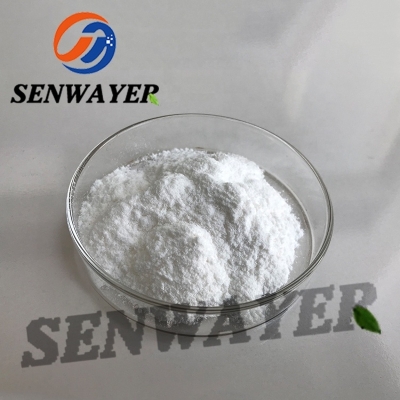New drugs approved by FDA in 2017: 3 milestones, 6 priority review coupons, 15 new tumor drugs
-
Last Update: 2018-01-02
-
Source: Internet
-
Author: User
Search more information of high quality chemicals, good prices and reliable suppliers, visit
www.echemi.com
Source: drug Rubik's cube 2018-01-02 in 2017, FDA drug evaluation and Research Center (CDER) approved 46 new drugs, including 34 new molecular entities (NME) and 12 new biological products (BLA) In addition, the center for biological products evaluation and Research (CBER) approved two cell therapies and one gene therapy The number of new drugs approved by FDA in 2017 has reached a new high in the past 20 years, more than twice the number in 2016 However, as Frank David, a columnist of Forbes, points out in his article, the number of NME approved by FDA actually reflects the clinical trials registered and carried out 2-3 years ago in the pharmaceutical industry There are two more batches this year and three fewer batches next year It is meaningless to compare this number in a short term So what about the long-term trend? The answer is that the number of new drugs approved by the FDA is on the rise as a whole From 2003 to 2005, FDA approved a total of 12 tumor drugs, while in 2017, FDA approved 15 new tumor drugs (including car-t therapy) According to Frank David's analysis, this result may be due to the fact that some disease areas (such as cancer) can bear the increasing drug price, and the FDA's incentive policy also encourages pharmaceutical companies to carry out "faster, lower cost, less risk" projects Nowadays, pharmaceutical companies are generally willing to carry out multiple small and medium-sized phase III clinical trials with shorter cycle, lower cost and less risk on the indications with larger price space at the same time Fewer and fewer enterprises are willing to devote their energy and funds to a large phase III trial, even if the clinical trial has significant clinical value From the perspective of disease field, tumor is still the major category of new drug output in 2017, accounting for about 1 / 3 of the total number of new drugs in the whole year By contrast, cardiovascular, respiratory and other diseases that have produced countless blockbusters are in the ascendant In addition to a record number of new drugs approved, the FDA also generously issued six priority review vouchers in 2017 Novartis, with its first car-t product launched on the market, has obtained a priority review voucher for rare pediatric diseases In addition, Novartis has purchased a priority review voucher from ultragenyx for us $130 million, and together with Gilead, it has become a "certificate collector" After the speculation, 130 million US dollars has also become the current reasonable price of priority evaluation bonds The global new drug research and development in 2017 is a "magnificent" year, with at least three milestones worth remembering: first, On May 23, FDA approved the use of keytruda in the treatment of patients with solid tumors with high microsatellite instability (MSI-H) or mismatch repair defect (dmmr), which means that keytruda has become the first cancer treatment method based on tumor markers instead of tumor location, which is of epoch-making significance in cancer history Second, the FDA approved Novartis kymariah on August 30 for use in the treatment of refractory or relapsed acute lymphoblastic leukemia (all) in adolescents under 25 years old Kymriah has become the first car-t therapy in the world Third, on December 19, the FDA approved the launch of the gene therapy luxturna (voretigene neuroparvovec rzyl) of spark therapeutics for the treatment of hereditary retinopathy Luxturna directly corrects genes in patients, which is a real gene therapy, marking the official arrival of the era of gene therapy We have paid attention to the 15 key clinical research data in 2018 More data of I-O, car-t and gene therapy will be released in 2018 We will wait and see more innovations and breakthroughs! Appendix: brief introduction of new drugs in 2017 1 The first urinogenin analog was developed by synergy pharmaceuticals It belongs to the guanosine cyclase-C (GC-C) agonist, which can stimulate the secretion of intestinal fluid, promote the normalization of intestinal function and regular defecation Trulance's approved dose regimen is 3mg orally, once a day, and can be taken at any time, regardless of eating Chronic idiopathic constipation is a complex functional gastrointestinal disorder Its symptoms include bowel movement less than 3 times a week, intestinal obstruction, etc the etiology and pathophysiological process are not clear CIC affects about 33 million Americans, 14% of the world's population In a large phase III, double-blind, placebo-controlled study involving 2600 patients, trulance significantly improved stool frequency (number of spontaneous stools per week) and consistency (measured by the Bristol stool scale) in 12 weeks compared with placebo The most common side effect of plecanatide is diarrhea, which is forbidden in children under 6 years old 2 Renal dysfunction and mineral metabolism disorder of parsabiv (etelcalcetide) can cause parathyroid gland to secrete a large amount of parathyroid hormone (PTH) and cause secondary hyperparathyroidism The incidence of this disease is about 88% in dialysis patients and 79% in hemodialysis patients Etelcalcetide, a new calcium mimetic, can bind to and activate PTH receptor, and then reduce PTH level Because it can be administered intravenously after hemodialysis, it is superior to the existing standard calcium mimetic agent sinacase Etelcalcetide was approved on February 7 for the treatment of secondary hyperparathyroidism in adult hemodialysis patients It is the first drug approved for the treatment of secondary hyperparathyroidism in dialysis patients in 12 years In two randomized, double-blind, phase III controlled trials, 1023 hemodialysis patients with moderate to severe secondary hyperparathyroidism (PTH > 400 pg / ml) were randomly given etelcalcetide or placebo at the end of dialysis (3 times / week) in addition to standard treatment (vitamin D and / or phosphate binder) The results showed that after 20-27 weeks of treatment, the proportion of patients with PTH level reduced by 30% from baseline in the etelcalcetide group was 77% and 79%, respectively, while that in the placebo group was 11% and 11%; the proportion of patients with PTH level ≤ 300 pg / ml in the etelcalcetide group was 52% and 56%, respectively, while that in the placebo group was only 6% and 5% 3 Emflaza (deflazacort) Duchenne muscular dystrophy (DMD) is an X-chromosome recessive genetic disease caused by dystrophin gene mutation, which mainly occurs in boys The disease affects an average of one in 3500 newborn boys worldwide Before school age, patients will suffer from muscle weakness or atrophy due to the continuous deterioration of skeletal muscle, which will lead to the inconvenience of walking Most of the DMD patients are 3-5 years old, 7-12 years old completely lose walking ability, 20 years old or so will die of myocardial and pulmonary myasthenia In September last year, the FDA conditionally approved the first DMD drug exondys 51 (eteplirsen) for DMD patients with exon 51 skipping in dystrophin gene, covering about 13% of DMD patients Different from Exondys 51, Emflaza is suitable for DMD patients with all types of gene mutations It is used for the treatment of DMD patients 5 years old and above It is the first corticosteroid drug approved to treat DMD in the world 4 Siliq (brodalumab) on February 15, FDA approved siliq (brodalumab) of Valeant pharmaceutical for the treatment of adult moderate and severe plaque psoriasis that does not respond to systemic therapy or light therapy (UV therapy), which belongs to the second-line drug Brodalumab is an IL-17R inhibitor It can selectively bind to IL-17 receptor and prevent IL-17A, IL-17F and other types of IL-17 from binding to receptor It is the third McAb approved by FDA after Novartis secukinumab and Lilly ixekizumab for IL-17 pathway Brodalumab was originally developed by Amgen, and then licensed to AstraZeneca and kylin Co., Ltd In May 2015, clinical data showed that brodalumab was related to the suicidal tendency of patients Amgen then announced to terminate the cooperation with AstraZeneca on brodalumab and gave up the development of brodalumab Three months after the separation of AstraZeneca and Amgen, in September 2015, AstraZeneca licensed brodalumab's exclusive global development and commercialization rights (except for Japan and other Asian countries, which are held by kylin) to Valeant for a total price of $445 million Siliq, though successful, has a black box warning of suicide risks 5 Xermelo (telotristatetprate) carcinoid tumors are rare and grow slowly, most of them are found in the gastrointestinal tract The incidence of carcinoid syndrome in carcinoid patients is less than 10%, which usually occurs after the tumor spreads to the liver In these patients, tumor cells release too much serotonin, leading to diarrhea Uncontrollable diarrhea syndrome will lead to weight loss, adverse effects, dehydration and electrolyte disorders In this case, somatostatin analogues can inhibit the secretion of some growth hormones and relieve the symptoms and signs related to functional gastrointestinal pancreatic enzyme endocrine tumors, but they have no specificity, only can alleviate the diarrhea of carcinoid syndrome, and easily cause the hormone secretion level in the patients The combination of FDA approved xermelo tablets and SSA can inhibit the production of serotonin and reduce the number of diarrhea in carcinoid syndrome by only taking orally three times a day 6 Kiscali (ribociclib) was approved by the FDA on March 13 Kiscali (ribociclib, lee011) of Novartis was approved to be on the market It was combined with aromatase inhibitor for the first-line treatment of HR + / HER2 - advanced or metastatic breast cancer Kisquali was approved by FDA with breakthrough drugs and priority review channels, and the review time of NDA was only 4.5 months Kisquali is the second listed CDK4 / 6 inhibitor in the world after Pfizer ibrance (palbociclib) In a phase III monaleesa-2 study involving 668 postmenopausal patients with HR + / HER2 - advanced or metastatic breast cancer, ribociclib combined with letrozole as a first-line treatment reduced the risk of disease progression or death by 44% compared with letrozole alone in the mid-term analysis The median PFS of ribociclib + letrozole group was significantly prolonged (19.3 months ~ not reached), and that of letrozole group was 14.7 months (13.0 ~ 16.5 months) After 11 months of follow-up, the PFS of the two groups were 25.3 and 16.0 months respectively Total lifetime data has not been obtained 7 Xadago Parkinson's disease is the second most common chronic progressive neurodegenerative disease in the elderly after Alzheimer's disease There are about 7-10 million patients in the world, including 1 million in the United States Parkinson's disease patients will appear "on-off phenomenon" in the later stage of drug treatment "On" refers to the obvious therapeutic effect of drugs on patients, and patients can exercise; "off" refers to the loss of patients' exercise ability "On-off phenomenon" will become more and more serious with the prolongation of drug treatment time In life, the patient suddenly becomes stiff and unable to move The stiffness lasts for several minutes, and then suddenly can move With the extension of the course of disease, the duration of this state is longer and longer, even the stiffness can last for several hours The "on-off phenomenon" is different from the motion disorder caused by the fluctuation of the disease itself, which is unpredictable and more common in the younger Parkinson's patients The FDA approved xadago as an adjuvant for patients undergoing levodopa / carbidopa treatment and going through the "off" phase 8 Symproic (naldemine) FDA approved naldemine for the treatment of constipation (OIC) caused by taking opioids in adult patients with non cancerous chronic pain Naldemedine is a peripheral μ opioid receptor antagonist taken orally once a day Constipation is one of the most common side effects of opioids Opioids
This article is an English version of an article which is originally in the Chinese language on echemi.com and is provided for information purposes only.
This website makes no representation or warranty of any kind, either expressed or implied, as to the accuracy, completeness ownership or reliability of
the article or any translations thereof. If you have any concerns or complaints relating to the article, please send an email, providing a detailed
description of the concern or complaint, to
service@echemi.com. A staff member will contact you within 5 working days. Once verified, infringing content
will be removed immediately.







